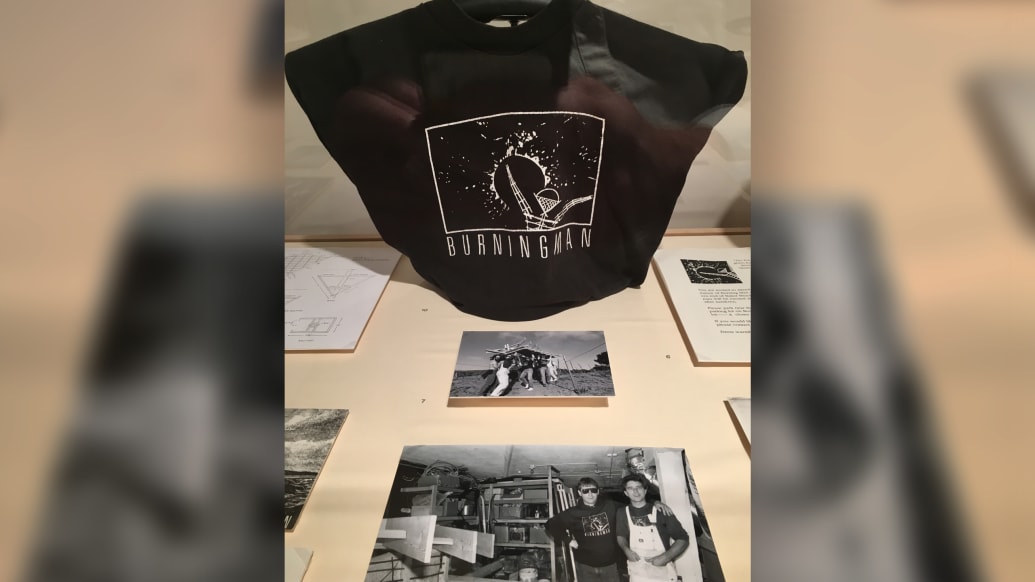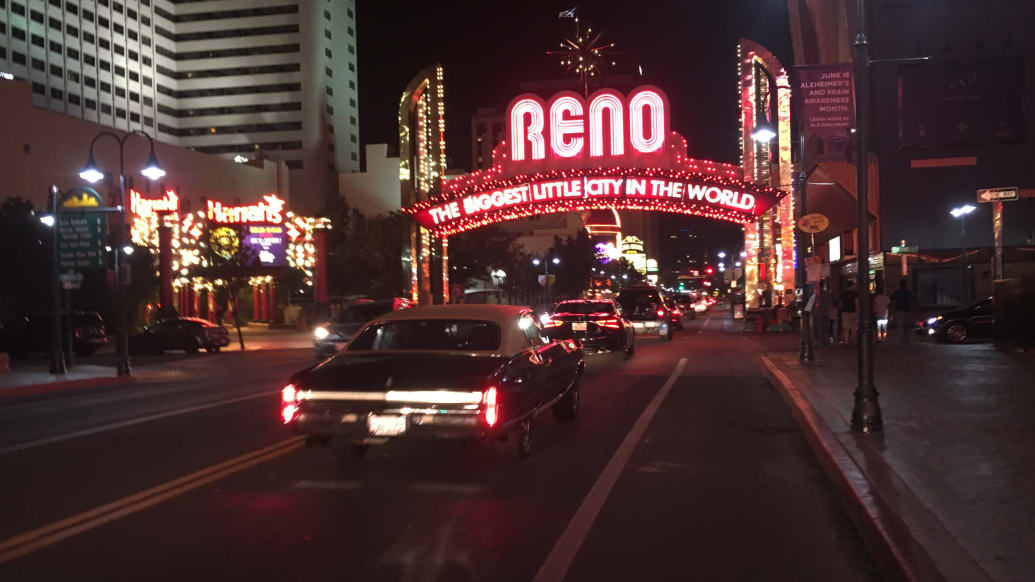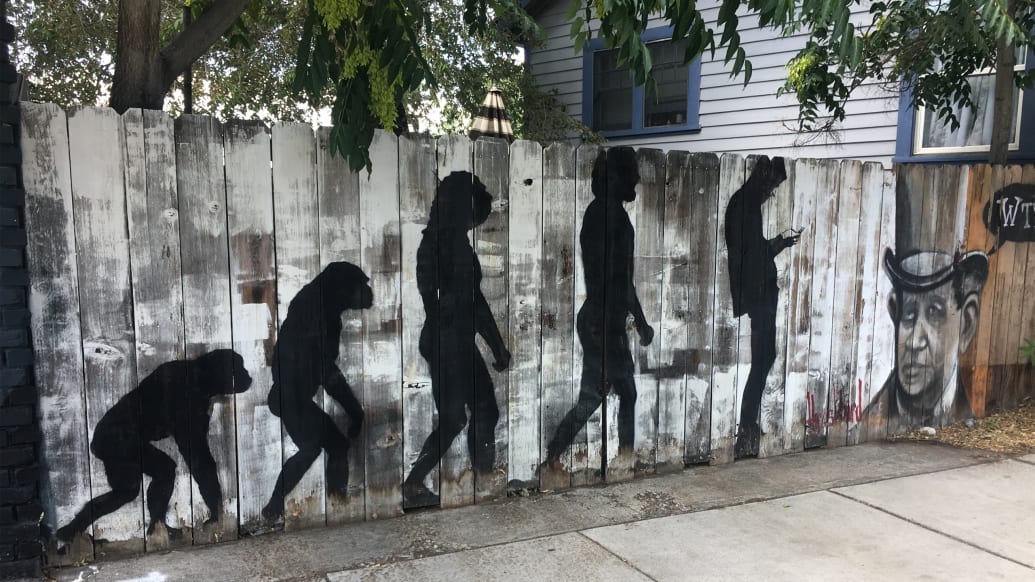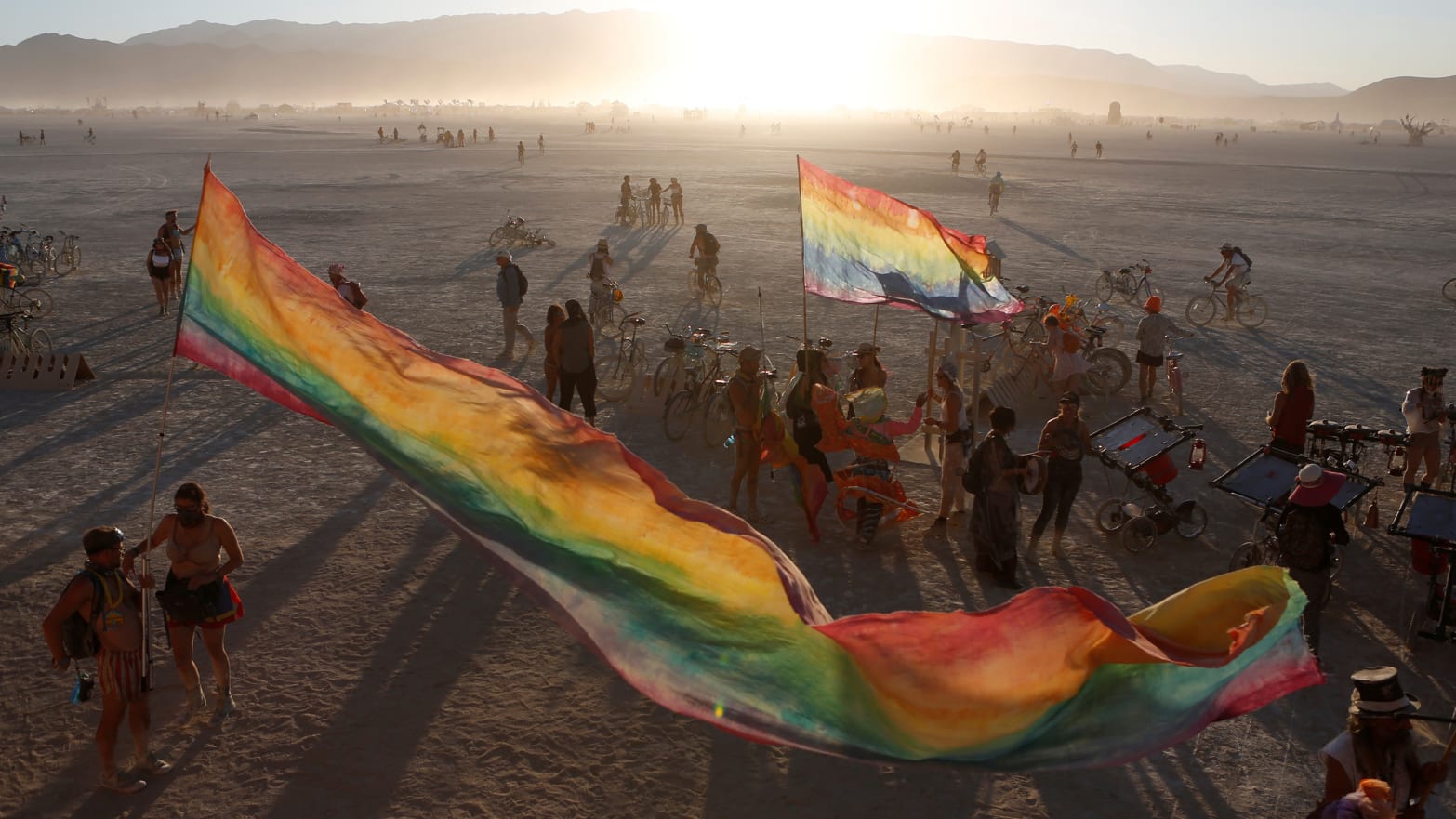Every year in August, as the summer heat peaks in the northern Nevada high desert, people start descending on Reno by the scores, then by the thousands.
They buy water by the pallet, booze by the case, and food to last for a week, plus faux-fur coats, booty shorts, wearable lights, goggles, boots, and much, much more. Then they disappear into the Black Rock Desert north of town. A week or so later they return, physically and emotionally exhausted, smelly, disheveled, and covered from hair to toenails in a fine white dust that marks nearly everything it touches, sometimes forever. They are “burners,” and they have just emerged from Burning Man, a raucous festival of art, indulgence, and DIY culture that draws tens of thousands from around the world each year.

Denver Nicks
Not that long ago, burners were pariahs to many in Reno, the biggest city and nearest major airport to the event. Once a year they came pouring into town with strange clothes and bizarre art, many presumed to be on or in possession of drugs, and returned a week later caked in a dust that was near impossible to remove from any seat cushion or hotel bed it touched.
But as Reno—facing a sharp downturn in its core industry, casinos—redefines itself into a hub for tech, art, and outdoor adventure, the town’s relationship to Burning Man has flipped.
“Clearly this community has conservative, pioneer values,” Doug Erwin, vice president at the Economic Development Authority of Western Nevada, told me. “There was hesitation to Burning Man in the beginning. But I think over time people started resonating with its ethos.” For proof, he says, look no further than the city’s permitting process. “If you want to hold an event, you get a form from the city and there’s literally a box to check for fire spinning,” he says. “How much more integrated can you be than becoming part of the bureaucracy?”

Denver Nicks
The change in Reno’s relationship to Burning Man is due, in part, to the fact that Burning Man itself helped spark a revitalization of Reno when the city was facing a bleak future. “Broadly, arts and culture have been leading the transformation,” Erwin says, “and Burning Man is obviously a major component of that. Nevadans resonate with that idea of do-it-yourself, self-expression, we’re going to do it our own way.”
Founded as a river crossing for gold and silver prospectors, Reno first made a name for itself with its liberal divorce laws, back when a divorce was harder to come by than it is today—the joke was that what happens in Vegas gets undone in Reno. Though always in the shadow of its gaming behemoth brother to the south, over the years Reno developed a sizable gaming industry of its own. But by the late-1990s the luster on the city’s casinos was fading fast, as clientele dried up owing largely to competition from new casinos on Native American land in northern California. Since 2000, according to the Center for Gaming Research at the University of Nevada, revenues from gaming in Reno have declined by nearly one-third and employment in gaming has fallen by well over half. Blight took over neighborhoods in and around the downtown core, and Reno seemed destined for decline.
Back then Burning Man was still a small, anarchic, and largely unknown happening that had emerged from the artistic milieu of the San Francisco Bay Area in the early 1980s. In the 1990s, the event moved to the Black Rock Desert, a bone-dry alkali plane in northern Nevada, flat and white as a canvas and prone to extreme weather and spontaneous dust storms—the sort of austere, unforgiving environment that kept away all but the most committed and the perfect place for a festival built around principles like radical self-reliance and radical self-expression that crescendos with the immolation of a gigantic humanoid sculpture, as is custom at Burning Man.
While Reno’s casino-based economy sputtered, the festival of bright lights, fire and larger-than-life art in the Black Rock Desert was growing like an incandescent weed. In 1990, the year Burning Man moved to Nevada, the event totaled all of 350 participants; by 1996, there were 8,000. In 2000, more than 25,000 people flocked to Burning Man, and nearly 40,000 in 2006. Almost 70,000 people have participated in Burning Man every year since 2013.

Denver Nicks
That explosive growth coincided with a renaissance in Reno, as the city has harnessed its can-do, pioneer spirit to pick itself up and redefine itself, particularly in the last five years. Since 2012, rent in Reno is up almost 20 percent, and a major regional growth study’s conservative projections have 50,000 new jobs coming to the area between 2015 and 2019. Many of these jobs are with tech giants like Google and Tesla—companies, incidentally, with well-established connections to Burning Man—but it’s not just tech titans that are transforming Reno.
Over the last few years at least three new non-smoking, non-casino hotels—once nigh unthinkable amenities in Reno—have opened downtown, including one, the Whitney Peak, with the world’s tallest climbing wall. The city promotes its proximity to one of the highest concentrations of ski resorts in America in the Sierra Nevada mountains, as well as the crystal clean waters of Lake Tahoe and outdoor activities on the Truckee River, including kayaking the rapids at Wingfield Park right smack in the middle of downtown.
The local food truck scene has blossomed from almost nil to 70 mobile eateries, which assemble for a massive, family friendly community gathering on Fridays at Idlewild Park. Local breweries, distilleries, bars, and restaurants are breathing life into recently blighted neighborhoods, like Midtown, where you can get a donut ice cream sandwich that is just as mouth-drenchingly delicious as it sounds right next door to Junkee Clothing Exchange, a second-hand shop that could be the costume room for Burning Man the musical.
The finger prints of Burning Man are all over Reno’s renaissance, most notably in the fact that there is art in the form of murals and sculptures absolutely everywhere. Much of it is literally art from Burning Man that was deposited in Reno after the event, like the Ichthyosaur, a dinosaur skeleton replica that began as a huge puppet on the playa and now lives at Reno’s children’s Discovery Museum. There’s the Morris Burner Hostel, a self-described “Burning Man-inspired housing facility” and community space. There are so-called maker spaces, like The Generator, where some of the most iconic pieces at Burning Man are built and assembled. And on any given day you’re likely as not to pass an art car—a Burning Man vehicle designed to look not like a car but something else entirely, like a pirate ship, or a gigantic flame-spitting octopus. “Because all that Burning Man art is so readily available, that stuff just shows up at lots of events and it just normalizes it in the community,” Erwin told me. “I kind of expect if I’m going to go downtown for some event now there’s going to be art cars.”
Burner and longtime Reno resident Maria Partridge helped spearhead the effort to bring Burning Man to Reno, she says, because of the cultural impact it would make there compared to another, bigger city. “Putting Burning Man art in San Francisco was kind of taken for granted back then,” she says. But in Reno it could make a difference.
In 2008, Partridge helped put a group of mangrove tree sculptures from Burning Man on three-month display in an empty lot in downtown Reno. People spontaneously started playing music there, which became a weekly event: Music in the Mangrove. “What happened is, it wasn’t just burners hanging out. It really became a community gathering spot where the burners were hula-hooping and doing our programming and the Reno community came down,” she says. Burners and Reno residents found they got along fine—“we weren’t so different,” Partridge says. That blossomed into what has become a regular feature of not just downtown Reno, but of parks, open lots, and even residences all over town: the art of Burning Man on temporary or permanent display.
Certainly part of the impact that Burning Man has had on Reno has come simply from dedicated burners making their home there. “A lot of people have moved from San Fran to Reno because it’s more affordable, especially artists. I think that has actually changed the nature of the population in Reno,” Partridge told me. One of Burning Man’s early founders, Michael Mikel, lives in Reno. Amanda Horn, a burner, is director of communications at Reno’s Nevada Museum of Art, which hosts “City of Dust: The Evolution of Burning Man,” an exhibition on Burning Man history and culture set to head to the Smithsonian in Washington, D.C., in 2018.
Part of what has helped changed Reno’s relationship to Burning Man since the early days is that Burning Man itself has changed. In the beginning “it was a lot more raw of an event, a lot more untamed, a lot less structure,” says Eric Baron, longtime Reno resident, a burner for more than 20 years and owner of the Melting Pot, a “counterculture shop” in Reno that served as one of the Burning Man community’s earliest hubs (its first ticket stand, for instance, back when you could walk up and buy a ticket in person). Since those chaotic early days, Reno and Burning Man have grown up to together, but for Baron, that’s only natural and the essential spirit of both remain. “We knew all along that this was museum-quality stuff that was going on out in the desert, and that it would all end up in a museum someday,” he told me. “But it’s kind of surreal that that day is now. Surreal and amazing.”

